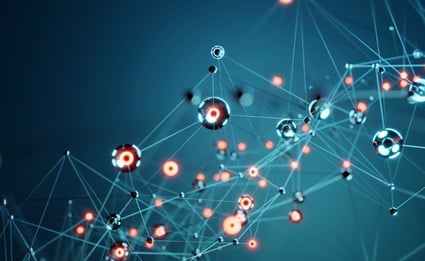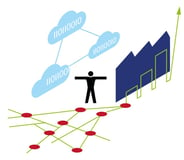Are Neural Networks and Deep Learning the Next Big Supply Chain Trends?
Jesse Kelber - September 01, 2020

By now, your supply chain should be no stranger to technology--whether you’re just beginning your organization’s digital transformation or you’re well on your way with multiple implementations of Industry 4.0 tech. Technology is the way forward for the resilient supply chain of the future. But how much do you truly know about the emerging technology set to power your supply chain into that technologically-driven future? For example, what do you think of when you hear the words “neural networks” or “deep learning?” If you shook your head in disbelief, or if your first inclination was to say something about the human brain, today’s article is for you. We’re going to look at how the combination of deep learning (DL) algorithms and the artificial neural networks (ANN) they power are set to have some significant impacts on the supply chain of this fourth industrial revolution.
Deep Learning and Artificial Neural Networks: An Overview
To talk about one of these technologies is really to talk about them both. Deep learning is the subset of machine learning that deals with creating the algorithms that power, you guessed it, neural networks. ANNs are adaptable systems of neurons consisting of algorithms that interact with each other in complex ways. These interactions have been likened to those between the neurons in the brain, hence the use of the term neuron. They learn by taking in data and running it through the DL algorithms in their configuration. These are the same algorithms that power natural language processing systems and the voice recognition circuit in your smartphone. They are also the same algorithms that control the filtering used on social media platforms to control what content you’re seeing.
How These Networks Will Make Waves in the Global Supply Chain
Now to bring this around to your primary focus, supply chain management. Just how are DL and ANN going to impact your daily workflow? What stages of your value chain could benefit the most from some optimization? Supply/demand mismatches due to forecast inaccuracy likely come up near the top of that list—and this is one area set to be disrupted. When customers don’t get what they want, when they want it, they tend to take their business to a competitor. When you put the multiple layers of analysis and computing power of an ANN to work, the results are a drastic reduction in the mismatch between what you’re producing and what your customers are demanding.
Neural networks can return more accurate insights, based on all available data, in record time. This is down to the multiple levels of interactions between algorithms that take in and process varied data streams simultaneously. This differs from the more prevalent generation of machine learning algorithms that have a single input leading to a single output. Planners have enough on their hands without dealing with the results of an inaccurate manual demand forecast. When you let the algorithm parse past customer buying habits, current market trends, and even weather patterns, what you get is the most accurate forecast possible. And because of the multiple inputs, you can run the algorithms for consistently fresh insights that allow you to adapt and pivot on a moment’s notice to keep up with your consumers and ahead of your competitors. But deep learning and neural networks have other strengths: adaptability and pattern recognition are prime examples.
Adaptability Is Crucial in Today’s Rapidly Changing Market
Consumer markets are volatile at the best of times. Buying patterns swing wildly from season to season, seemingly on a whim. And today’s market is anything but typical, with the impact of a global pandemic yet to be fully realized. Setting yourself up for resilience moving forward is going to be mandatory for surviving the coming unknown, to say nothing of thriving. ANNs can pivot, on their own, based on what they learn ingesting your data streams. Deep learning algorithms are appropriately named since their primary focus is on building systems that can learn from daily activity, mistakes, and solutions alike.
As a use case, say you feed your neural network last year’s sales figures, the current quarter’s demand forecast, and global consumer purchasing outlooks. Then, you can take the insights you receive and adjust stock levels to a different warehouse or divert container ships to another port of call to locate product more strategically. Voila! You’ve just shortened shipping times because now stock will be located closer to your buyers, which means happier customers. Doing this on a shortened cycle of, say, 30 days means that you’ll be able to keep up with changing conditions in real-time and never have to play catch up again.
Pattern Recognition Is for More Than Just Finding Waldo
You likely know the idea behind pattern recognition from the kids’ books Where’s Waldo? (or Where’s Wally? depending on your location). In these books, a series of pictures include Waldo in his trademark sweater and hat, somewhere amidst the chaos of street scenes. How long do these take you to solve? Imagine how much faster a neural network running on algorithms that can compute thousands of times faster than your brain could perform the same task. The ability to ingest mountains, and we mean terabyte after terabyte, of data and come up with real-time actionable insights is pattern recognition on a whole new scale. During the process of learning what it is you want recognized—say consumer trends in Oceania—the algorithms behind your ANN are pulling out tidbits that would have escaped a human’s eyes and using them to assemble predictions no person could ever match.
Explainable AI Is the Future, and It’s Almost Here
Explainable AI is the term used to describe a situation whereby a person can specify not only what data went into an algorithm, but also how that algorithm came up with the results it did. No longer is data going to be fed into a black box of code, only to have seemingly inexplicable results come out the other end. While these results may be exactly what you needed, you have zero clues about how they were reached. Since ANNs work on the same model as the human brain, which has been studied for generations, we can break down the processes and inner workings to a level that any audience can grasp what went on to create the insights they’re now using to streamline their supply chain. Whether it’s your inventory management, logistics network routing, or demand planning, deep learning and neural networks are the future.
If you want to learn more get your Guide to Industry 4.0:
LATEST POSTS
- Understand Circular Economy in The Manufacturing Industry
- How Can Industry 4.0 IT Integration Be Achieved Smoothly?
- The Significance of Order Sequencing in Discrete Manufacturing
- How to improve your Supply Chain Management: The Power of Control Towers
- Optimizing Human Resource Scheduling in Manufacturing: A Technological Approach



